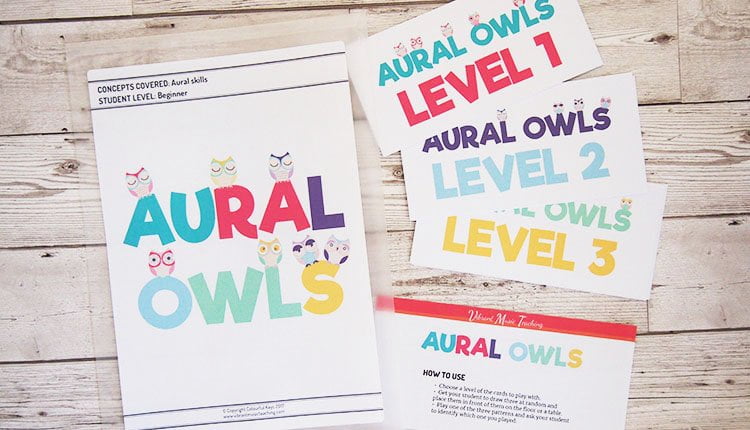What are the underlying skills that students need for music reading? What needs to be in place for our music students to become great sight readers?

The Sightreading Supercharge course is about to be released in the Vibrant Music Teaching library, and I’ve just opened sign-up for the free webinar about sight reading skills (register for the free webinar here), so music reading has been on my mind.
For me, it comes down to these four essentials:
- Melodic shape
- Steady beat
- Intervals
- Note names
Sure, there are other factors we could talk about. But these are the foundations.
So in this post, I want to walk you through each one and some super fun and effective ways you can teach it.
Music Reading Foundation 1: Melodic shape
The first thing, the absolute foundation of great music reading, is for students to see the shape of the music.
Does it go up or down? What line does it make?
Yes, from there, they will need to know the specifics to play it correctly. But even with just the shape, they’ll have a good chance of getting across the rough idea when sight reading a new piece of music.
Let’s take a look at some activities you can use to help your students notice the shape of the melody.
Point and Say
This is exactly what it sounds like. In this strategy, you have your student point to each note and say whether it’s up, down or same.
In the beginning stages this might be quite slow but over time it will turn into a quick check you do when starting a new piece, and it can make a big difference.
Tracing
Take it one step further from time to time and place a semi-transparent piece of paper over your student’s music. Ask them to “join the dots” between all the note heads so they can see the contour.
Use lots of colours for dramatic effect. 😉
Ribbon
Get a big piece of ribbon or string and ask your student to recreate the melodic line they see in the new piece. Then ask them to sing roughly this shape, sliding up and down to match the line.
These floor squiggles are great fun and can help your student to see the shape on a grand scale.
Aural Games
A game called Aural Owls which I released recently in the Vibrant Music Teaching community (VMT members download here) works on matching short aural phrases to the visual pattern.
Paying attention to the patterns will mean that students pay more attention to these overall shapes and lines rather than focusing in on individual notes.
Music Reading Foundation 2: Steady beat
What disrupts sight reading more commonly than anything else?
- Pauses and hesitations
- Going back to mistakes
- Unwanted accelerandos!
What doesn’t matter as much as students think it does?
- Wrong notes!
A piece of music with a steady beat and some random wrong notes thrown in generally sounds just fine. A performance with perfect note accuracy without a steady beat sounds pretty terrible.
That’s why step 2 on our journey to great music reading is to cultivate a steady beat.
Duets
If you eavesdropped on a duet session with me and one of my students you’d probably hear me say this at least once:
“This train is not stopping!”
When student play duets often enough they’re forced to make rhythm and beat a priority because their partner is not going to wait for them to figure out the notes or fix an error.

This only works if you keep the train moving!
Make it a habit to play duets with your students often and don’t compromise on the beat. If they’re seriously struggling just offer to start again at a slower tempo.
Rhythm Section
Rhythm instruments are a fantastic addition to piano lessons. You can pick up a set of educational rhythm instruments pretty cheaply and once you have them you’ll start bringing them into your teaching more and more.

Start by getting your student to become your drummer.
- Get your student to start a steady beat with a rhythm instrument of their choice.
- Tell them not to speed up or slow down no matter what.
- Join in by playing one of their pieces at whatever speed they chose.
This has the added bonus of getting your students to listen to their piece and get used to how it should sound. Win-win.
Music Reading Foundation 3: Intervals
Nope! We’re still not at note names!
Intervals are the next layer of music reading that we need to unpack. Intervals are more important than note names because that’s really how competent music readers are thinking, most of the time.
Colouring
Get your students to pick a different colour for each of the intervals in their piece. Then, go through and draw a line between melodic intervals in those colours and circle the harmonic intervals in the same colours.
If you’re concerned about covering your students’ books in colouring pencil then you can use a photocopy for this exercise.
This process, done consistently, will do wonders for your student’s ability to see the patterns in their music. So important for fluent music reading.
Interval Games
Music theory games are a great way to get lots of practice working with intervals. Away from the piano, students can focus more clearly on identifying patterns and learning to recognise them – without being worried about playing wrong notes.
Vibrant Music Teaching members can find tons of different interval games in the library by selecting “Intervals” from the “Notation” menu.
If you’re not a member you can download one of these games for free by entering your details below.

Subscribe to the newsletter and get the Bananas and Ladders game
Enter your details to subscribe to the newsletter for piano teachers with information, tips and offers.
I hate spam as much as you do! I will only send you emails related directly to piano teaching and you can unsubscribe at any time.
VMT members click here to go directly to Bananas and Ladders.
Music Reading Foundation 4: Note names
Did you think I was going to start here?
I hope I’ve convinced you throughout this post that note naming is not the deciding factor when teaching music reading.
But, of course, we do need note names too. Once your students are on their way to understanding shapes, intervals, and keeping a steady beat – you can try some of these gamified note naming activities to accelerate their progress even more.
60 Second Challenge
The 60 Second Challenge is a long-time favourite in my studio. You can read more about the challenge and how I use it in my studio here.

Basically, it’s just note flashcards, but boy do my students love it! They need to name and play a certain number of cards in under a minute 3 weeks in a row to achieve each level and we have great fun working on it.
VMT members click here to download the 60 Second Challenge pack.
Note naming games
To further reinforce and practice note names, nothing beats great music theory games in my opinion.
Vibrant Music Teaching members can find heaps of different note name games in the library by selecting “Note Names” from the “Notation” menu.
If you’re not a member you can download one of these games for free by entering your details below.

Subscribe to the newsletter and get the Journey to Phoenix Park game
Enter your details to subscribe to the newsletter for piano teachers with information, tips and offers.
I hate spam as much as you do! I will only send you emails related directly to piano teaching and you can unsubscribe at any time.
VMT members click here to go directly to Journey to Phoenix Park.
Which of these foundations of music reading do you find hardest to teach?
Did I give you some new ideas to try in this article? I’d love to hear what you think in the comments below or in the Vibrant Music Studio Teachers group on Facebook.




Excellent article – thank you very much. I particularly liked the activities in the Melodic Shape section, which have gone on my to try list for the week.
Always enjoy the part of Sunday when your email pops up in my inbox!
Great to hear Elaine! Let me know how you get on with those activities.
I like the melodic contour with ribbons activity. I’ve used small magnets before but some students find the magnets too fun to play with!
I like that the ribbons are more about giving the general shape too, magnets might make them focus on specific notes. 🙂